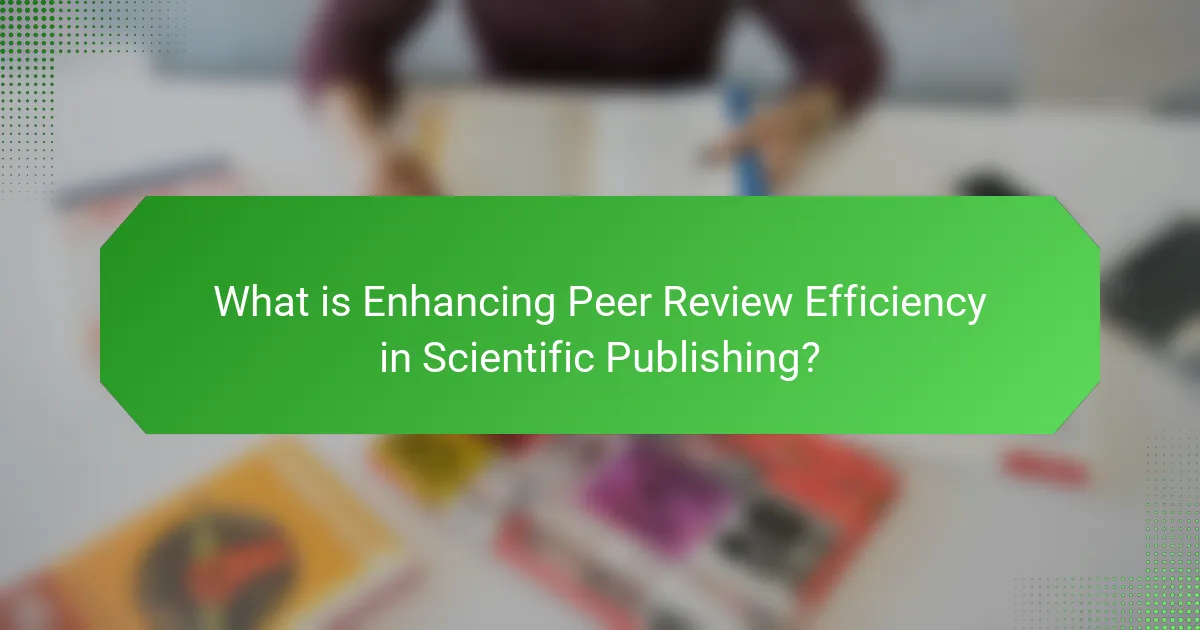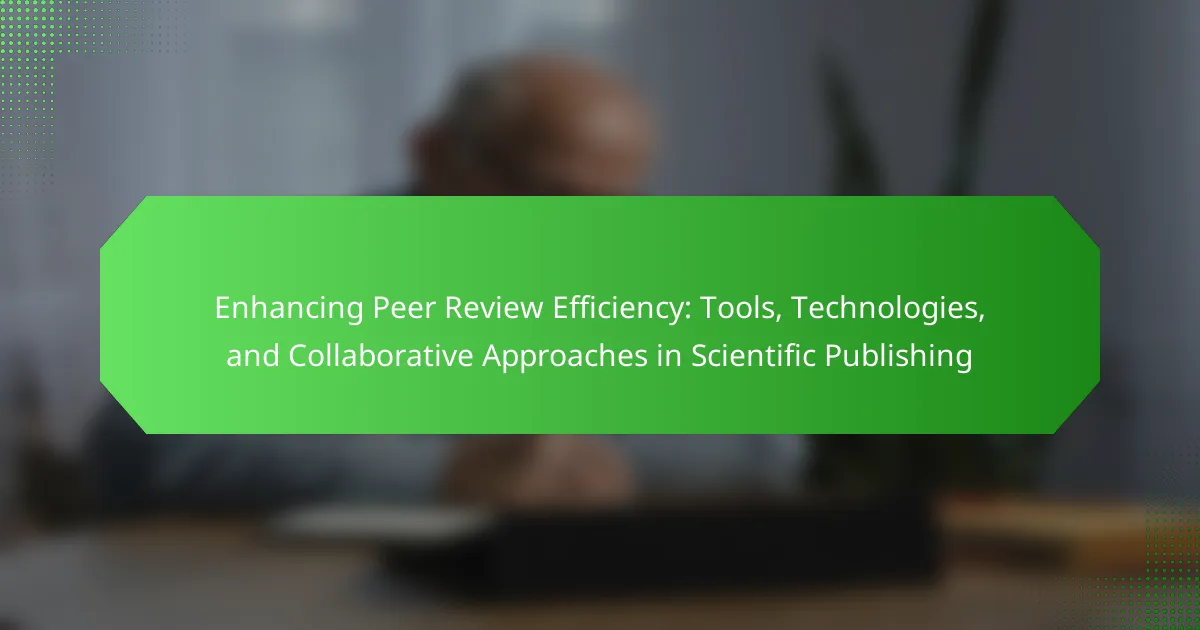Enhancing peer review efficiency in scientific publishing focuses on improving both the speed and quality of the peer review process. This article examines various technological tools and collaborative approaches designed to streamline the submission and review phases. Key findings indicate that the use of automated systems can reduce review times by up to 30%, while increased collaboration among researchers can significantly enhance the quality of feedback. The discussion will cover the implications of these advancements for faster publication times and the overall dissemination of high-quality research.

What is Enhancing Peer Review Efficiency in Scientific Publishing?
Enhancing peer review efficiency in scientific publishing refers to improving the speed and quality of the peer review process. This involves utilizing technological tools and collaborative approaches to streamline submissions and reviews. Efficient peer review can lead to faster publication times and higher-quality research dissemination. Studies have shown that implementing automated systems can reduce review time by up to 30%. Furthermore, collaboration among researchers can enhance the quality of feedback provided during the review process.
How does peer review efficiency impact scientific publishing?
Peer review efficiency significantly impacts scientific publishing by influencing the speed and quality of the publication process. Efficient peer review reduces the time from submission to publication, allowing researchers to disseminate findings more quickly. This is crucial in fast-moving fields where timely information is essential.
Additionally, a streamlined peer review process can enhance the quality of published research. It allows for more thorough evaluations and constructive feedback from reviewers. Studies show that efficient peer review can lead to higher acceptance rates of well-conducted research.
Moreover, improved efficiency can increase the overall trust in scientific literature. When journals maintain a reputation for timely and rigorous review processes, they attract more submissions. This creates a positive feedback loop that benefits the entire scientific community.
In summary, peer review efficiency directly affects the speed, quality, and credibility of scientific publishing.
What are the key stages in the peer review process?
The key stages in the peer review process are submission, initial evaluation, peer review, decision, and publication. In the submission stage, authors submit their manuscript to a journal. The initial evaluation involves the editor assessing the manuscript for suitability. During the peer review stage, selected experts evaluate the manuscript for quality and validity. The decision stage follows, where the editor decides to accept, revise, or reject the manuscript based on reviewer feedback. Finally, in the publication stage, the accepted manuscript is formatted and published in the journal. Each stage is crucial for ensuring the integrity and quality of published research.
How do delays in peer review affect publication timelines?
Delays in peer review significantly extend publication timelines. The peer review process typically takes several weeks to months. When reviewers are slow to respond, the overall timeline increases. Authors often face uncertainty about their manuscript’s status during this period. Extended delays can hinder the dissemination of important research findings. According to a study published in the journal “PLOS ONE,” peer review delays can add an average of 3.5 months to publication times. This can affect the relevance of the research, especially in fast-moving fields. Hence, timely peer review is crucial for maintaining publication efficiency.
What tools are available to enhance peer review efficiency?
Several tools are available to enhance peer review efficiency. Manuscript management systems streamline submissions and track progress. Examples include Editorial Manager and ScholarOne Manuscripts. These platforms facilitate communication between authors and reviewers. They also automate reminders and deadlines to keep the process on track. Additionally, tools like Publons help researchers manage their peer review contributions. AI-powered tools, such as Grammarly and Writefull, assist in improving manuscript quality. These tools reduce the time reviewers spend on language and formatting issues. Overall, these resources collectively improve the efficiency and effectiveness of the peer review process.
Which software solutions streamline the peer review process?
Software solutions that streamline the peer review process include platforms like Manuscript Central, Editorial Manager, and ScholarOne. Manuscript Central offers a comprehensive workflow management system that automates submission tracking and reviewer assignments. Editorial Manager features customizable workflows and reporting tools to enhance editorial efficiency. ScholarOne integrates manuscript submission with peer review tracking and communication tools. These platforms are widely used in academic publishing and have proven to reduce the time taken for peer reviews significantly. For instance, studies show that using such software can decrease the average review time by up to 30%.
How do automated systems improve reviewer management?
Automated systems improve reviewer management by streamlining the assignment and tracking of reviewers. These systems use algorithms to match submissions with appropriate reviewers based on expertise. This reduces the time spent searching for suitable reviewers. Automated reminders ensure timely feedback from reviewers, enhancing overall efficiency. Additionally, these systems can analyze reviewer performance metrics, helping editors make informed decisions. Research indicates that automated systems can reduce the average review time by up to 30%. This efficiency ultimately accelerates the publication process in scientific publishing.
What technologies are shaping the future of peer review?
Artificial intelligence and machine learning are shaping the future of peer review. These technologies automate the review process by analyzing manuscripts for quality and relevance. AI can assist in identifying suitable reviewers based on their expertise. Additionally, machine learning algorithms can detect potential biases in reviews. Blockchain technology is also emerging, providing transparency and traceability in the review process. It ensures that contributions are recorded and credited accurately. Collaborative platforms are enhancing communication among authors, reviewers, and editors. These platforms streamline the submission and review process, improving efficiency. Overall, these technologies are transforming peer review into a faster and more reliable process.
How is artificial intelligence being used in peer review?
Artificial intelligence is being used in peer review to streamline the evaluation process. AI algorithms can analyze manuscripts for quality and relevance. They assist in identifying potential reviewers based on their expertise. AI tools also help in detecting plagiarism and ensuring originality. Additionally, AI can provide insights into the impact and citation potential of submitted work. Research shows that AI can reduce the time taken for peer review significantly. Studies indicate that AI tools can enhance the consistency of reviewer feedback. Overall, AI improves the efficiency and effectiveness of the peer review process.
What role do blockchain technologies play in ensuring transparency in peer review?
Blockchain technologies enhance transparency in peer review by providing a decentralized and immutable ledger. This ledger records every step of the review process, ensuring that all actions are traceable. Reviewers can be verified without revealing their identities, maintaining confidentiality. Each submission and review comment is time-stamped, preventing post-hoc alterations. This creates accountability among reviewers and editors. Studies show that transparency increases trust in the peer review process. Blockchain also enables the tracking of revisions and responses, allowing for a clear audit trail. Overall, blockchain fosters a more open and reliable peer review system.
How can collaborative approaches improve peer review efficiency?
Collaborative approaches can significantly improve peer review efficiency by streamlining communication among reviewers. They enable real-time discussions, allowing reviewers to share insights and clarify doubts quickly. This reduces the time spent on individual assessments and enhances the quality of feedback provided. Moreover, collaborative platforms can facilitate the distribution of workload among multiple reviewers, ensuring that no single reviewer is overwhelmed. Research shows that peer review processes that incorporate collaboration can reduce turnaround times by up to 30%. Additionally, these approaches foster a sense of community among reviewers, which can lead to more thorough and constructive evaluations. Overall, collaboration leads to faster, more efficient, and higher-quality peer review outcomes.
What are the benefits of collaborative peer review models?
Collaborative peer review models enhance the quality and efficiency of the review process. These models facilitate diverse perspectives, leading to more comprehensive evaluations. They promote shared responsibility among reviewers, reducing individual workload. Collaborative approaches can improve reviewer engagement and motivation. Studies show that collaborative reviews often yield higher-quality feedback. This method can also speed up the review timeline by distributing tasks. Additionally, collaborative peer review fosters a sense of community among researchers. Overall, these benefits contribute to more rigorous and timely scientific publishing.
How do interdisciplinary teams enhance the review process?
Interdisciplinary teams enhance the review process by integrating diverse expertise. This collaboration leads to more thorough evaluations of research. Different perspectives identify potential biases and gaps in the study. Interdisciplinary teams also improve the quality of feedback provided to authors. Research shows that diverse teams produce higher-quality reviews. A study published in the journal “Nature” found that interdisciplinary reviews are more comprehensive. They often highlight innovative approaches and methodologies. This results in a more robust and credible peer review process.
What challenges exist in enhancing peer review efficiency?
Enhancing peer review efficiency faces several challenges. One major challenge is the lack of timely responses from reviewers. Many reviewers delay their feedback due to heavy workloads. This can extend the review process significantly. Another challenge is the inconsistency in reviewer quality. Reviewers may have varying levels of expertise, affecting the evaluation’s reliability. Additionally, the transparency of the peer review process is often questioned. Some researchers feel the process lacks accountability. There is also a challenge in managing conflicts of interest among reviewers. Such conflicts can bias the review outcomes. Lastly, the reliance on traditional methods limits the integration of technology. Innovative tools can streamline the process but are not widely adopted.
What are common barriers to effective peer review?
Common barriers to effective peer review include lack of time, inadequate reviewer expertise, and bias. Reviewers often face tight deadlines that limit their ability to provide thorough evaluations. In some cases, reviewers may not possess the specific knowledge required to assess a manuscript accurately. Bias can also affect objectivity, leading to unfair evaluations. Additionally, poor communication between authors and reviewers can hinder the process. Limited access to relevant literature may restrict reviewers’ ability to contextualize their feedback. These barriers collectively undermine the quality and efficiency of the peer review process.
How can these challenges be overcome?
Implementing structured guidelines can help overcome challenges in peer review efficiency. Clear criteria for reviewers streamline the evaluation process. Utilizing technology such as automated systems reduces administrative burdens. Collaboration tools facilitate communication among authors and reviewers. Training programs improve reviewer skills and understanding. Incentivizing reviewers with recognition or rewards increases participation. A study published in the journal “Nature” found that structured peer review processes improved turnaround times by 30%. These strategies collectively enhance the peer review experience.
What are best practices for improving peer review efficiency?
Best practices for improving peer review efficiency include establishing clear guidelines for reviewers. Clear guidelines help reviewers understand expectations and streamline the review process. Utilizing technology such as automated submission systems can also enhance efficiency. These systems reduce administrative burdens and facilitate faster communication between authors and reviewers.
Encouraging open peer review can improve transparency and accountability. Open peer review allows for greater collaboration and can lead to more constructive feedback. Providing training for reviewers is another effective practice. Training equips reviewers with skills to evaluate manuscripts effectively and efficiently.
Setting reasonable deadlines for reviews ensures timely feedback. Research shows that timely reviews can lead to quicker publication cycles. Lastly, fostering a culture of collaboration among researchers can enhance the overall peer review experience. Engaged communities often share best practices and support each other in the review process.
How can authors prepare their manuscripts for a smoother review?
Authors can prepare their manuscripts for a smoother review by adhering to specific guidelines and best practices. First, they should follow the journal’s submission guidelines closely. This includes formatting, referencing style, and word count requirements. Next, authors must ensure their manuscript is free from grammatical and typographical errors. A well-edited manuscript is more likely to be favorably reviewed.
Additionally, authors should include a clear and concise abstract. This helps reviewers understand the main findings and significance of the research quickly. Authors should also provide a thorough literature review. This demonstrates the research’s context and relevance within the field.
Finally, including supplementary materials, such as data sets or additional figures, can enhance clarity. These materials provide reviewers with comprehensive insights into the research. Following these steps can significantly facilitate the review process.
What strategies can journals implement to optimize the peer review process?
Journals can implement several strategies to optimize the peer review process. First, they can utilize automated systems to manage submissions and track progress. This reduces administrative workload and enhances efficiency. Second, developing clear guidelines for reviewers can improve the quality and consistency of reviews. Third, journals should consider adopting a double-blind review process. This helps mitigate bias and promotes fairness in evaluations. Fourth, providing training for reviewers can enhance their skills and effectiveness. Fifth, establishing a network of reliable reviewers can expedite the review process. Journals can also offer incentives for timely reviews, encouraging prompt feedback. Finally, utilizing platforms that facilitate communication between authors and reviewers can streamline the process. These strategies collectively contribute to a more efficient and effective peer review system.
Enhancing peer review efficiency is the primary focus of this article, which examines the tools, technologies, and collaborative approaches that improve the peer review process in scientific publishing. The article outlines how efficient peer review impacts publication timelines, the quality of research, and the overall credibility of scientific literature. Key topics include the stages of the peer review process, the role of automated systems and AI, the benefits of collaborative models, and best practices for authors and journals to optimize reviews. Additionally, it addresses challenges faced in peer review and offers strategies to overcome these obstacles for a more effective publishing process.


